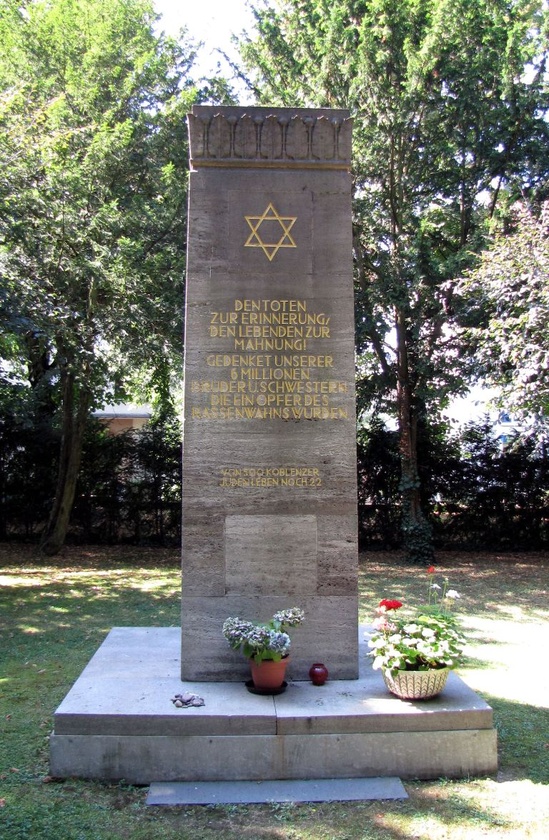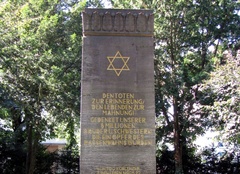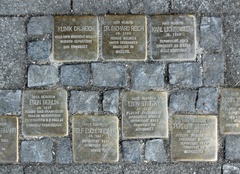Koblenz
French: Coblence
The first mention of Jews in the town of Koblenz occurred around the year 1104 in a document describing taxes. Jews were often made to pay higher rates and were restricted from practicing many professions. Therefore, many earned their living through finance. By the late 1200s Jews played an important role in the life of Koblenz, serving as moneylenders to high-ranking members of the nobility and city government. The first Jewish cemetery in Koblenz was consecrated in 1303.
The following centuries saw periods of legal protection that alternated with waves of persecution. One of the worst periods of oppression occurred after Jews were blamed for the Black Death in the mid-1300s. The Medieval Jewish community of Koblenz was annihilated and no Jews were officially allowed to return to the city until the early 1500s. A 1512 charter granted permission for only five Jewish families to settle in Koblenz.
Over the next few hundred years a small Jewish community endured in the town despite continuing restrictions on where Jews could live, what type of clothing they could wear, and what jobs they could hold. In 1702 the community built its first synagogue and in 1772 a Jewish welfare organization was founded.
It was not until the early 1800s, when France ruled over the Rhineland, that Jews were finally granted equal rights as citizens. Even then, their movement and trade were restricted.
The 1815 Congress of Vienna allocated Koblenz and the Rhineland to the Prussian (German) Empire. Enduring antisemitism sometimes resulted in outbursts of violence such as the Hep! Hep! Riots of 1819. Despite ongoing prejudices, in 1842 a Jew was elected to the city council. A second synagogue was built in Koblenz in 1851, about 150 years after the first. The new synagogue was located in a cluster of buildings that also included a Jewish school, two health clinics and housing for the community rabbi.
The period of the late 1800s saw improved economic growth in Koblenz, as industrialization allowed Jews to take advantage of opportunities in the food and clothing industries. In 1879 a Jew became a district judge.
Still, prejudices against Jews never completely disappeared and the antisemitism that began to rise in the 1890s only intensified after World War I (1914-1918). At the end of the conflict Koblenz was again occupied by France until 1923.
The Jewish community of Koblenz reached its peak of about 800 members in 1928, but would be completely destroyed only 15 years later. After Hitler came to power in 1933 Jewish businesses were boycotted. The town’s synagogue was burned down during the night of Kristallnacht in November 1938. Following this incident about 350 Jews were able to escape Koblenz. By May 1939 only about 300 remained in the town.
From 1942 to 1943 any Jews still living in Koblenz were deported to concentration camps. Only 22 survived the Holocaust.
Koblenz: Photographs & Artifacts
-
 This view of Koblenz from 1549 shows the meeting of the Rhein and Moselle Rivers. Sebastian Jünger / Wikimedia Commons / Public Domain
This view of Koblenz from 1549 shows the meeting of the Rhein and Moselle Rivers. Sebastian Jünger / Wikimedia Commons / Public Domain -
 This postcard depicts a view from the Old Mosselle Bridge in Koblenz. It dates from about 1850, around the same time that a second synagogue was built in the city. Wikimedia Commons / Public Domain (PD-1996)
This postcard depicts a view from the Old Mosselle Bridge in Koblenz. It dates from about 1850, around the same time that a second synagogue was built in the city. Wikimedia Commons / Public Domain (PD-1996) -
 A memorial for the Jews of Koblenz. It reads: "The dead in memory, the living as a reminder! Remember our 6 million brothers and sisters who were the victims of racial fanaticism. Of the 500 Jews of Koblenz, 22 still live." © Holger Weinandt / Wikimedia Commons / CC-BY-SA-3.0-DE
A memorial for the Jews of Koblenz. It reads: "The dead in memory, the living as a reminder! Remember our 6 million brothers and sisters who were the victims of racial fanaticism. Of the 500 Jews of Koblenz, 22 still live." © Holger Weinandt / Wikimedia Commons / CC-BY-SA-3.0-DE -
 These "Stoplersteine" in Koblenz serve as a memorial to the victims of the Holocaust. © Holger Weinandt / Wikimedia Commons / CC-BY-SA-3.0-DE
These "Stoplersteine" in Koblenz serve as a memorial to the victims of the Holocaust. © Holger Weinandt / Wikimedia Commons / CC-BY-SA-3.0-DE



